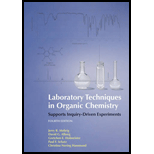
Interpretation:
The compound with greater
Concept introduction:
Thin-layer chromatography is an analytical technique used to identify whether two compounds are identical or not and also to find the number of compounds in a mixture.
Metal, glass or plates made of plastics are utilized in TLC that are coated by a thin layer of adsorbent and it acts as a stationary phase. The stationary phase usually used is polar silica gel. A mixture of solvents or single pure solvent is the mobile. It is also known as a developing agent. Mostly nonvolatile solid organic samples are analyzed by thin-layer chromatography. However, TLC cannot be used for volatile liquid compounds because it leads to loss of the sample by evaporation from the TLC plate.
In TLC analysis, mixture in a low quantity is taken for separation and dissolved in the suitable solvent and applied on the TLC plate. Then TLC plate is kept in the closed chamber immersed in mobile phase known as developing solvent. Through capillary action the solvent rises on the stationary phase. As the solvent rises on the plate, the sample is distributed between the mobile phase and the stationary phase on the basis of their retention values. The more the compound interacts with the stationary phase, the more slowly it moves on the TLC plate. When silica gel that is polar in nature behaves as the stationary phase then mobile solvent rises with the nonpolar substances up on the plate most rapidly. In the chromatogram, the polar substances rise up plate with lowest rate.
The ratio of distances covered by the compound to the distance covered by developing solvent or mobile front is known as retention factor
The
Want to see the full answer?
Check out a sample textbook solution
Chapter 18 Solutions
Laboratory Techniques in Organic Chemistry
- ogin - PaymentN MapQuest 3 Overview - SAP NetW... Draw the major product of this reaction. Ignore inorganic byproducts. CI 1. NaBH4 2. H₂O C Clever | Portal Job Op Problem Atoms, Bonds and Rings Draw or tap a new bond toarrow_forward2. Draw the remaining two resonance structures for the carbocation intermediate in the meta nitration of methyl benzoate AND explain why the meta orientation is preferred. Hint: how is the placement of the cation favorable after addition of nitronium relative to the electron withdrawing group? (2 pts) H NO2 CO₂Mearrow_forwardLabel all absorptions over 1500 cm-1. Please be specific and mark IR if needed for explanation. Compound OH sp^3 C-H C=O C-O Triglyceridearrow_forward
- Identify the intermediate that is INITIALLY formed in a saponification reaction (hydrolysis of an ester). III -OH H₂O HO OH HO O || A B C III D IV IVarrow_forwardHelp me answer this practice sheet I found for an answer guidearrow_forwardshow the retrosynthesis of this molecule step by step starting with 1,3-dimethoxy benzene H3CO OH OH OCH 3arrow_forward
- Consider the reaction of a propanoate ester with hydroxide ion shown below. A series of four alcohol leaving groups were tested to determine which would be the best leaving group. Based on the pKa values of the alcohols, predict which alcohol would produce the fastest hydrolysis reaction. HO FOR A Alcohol I, pKa =16.0 B Alcohol II, pKa =10.0 C Alcohol III, pKa = 7.2 + ROH D Alcohol IV, pKa = 6.6arrow_forwardCurved arrows are used to illustrate the flow of electrons. Using the provided starting and product structures, draw the curved electron-pushing arrows for the following reaction or mechanistic step(s). Be sure to account for all bond-breaking and bond-making steps. :0: NaOH, H₂O 00:4 Na O heat NaO Select to Add Arrows Select to Add Arrows :0: Na a NaOH, H2O :0: NaOH, H2O heat heat Na ONH Select to Add Arrowsarrow_forwardCurved arrows are used to illustrate the flow of electrons. Using the provided starting and product structures, draw the curved electron-pushing arrows for the following reaction or mechanistic step(s). Be sure to account for all bond-breaking and bond-making steps. H CH3NH3+ :0: :0: HO CH3NH2 HH iSelect to Add Arrows i Select to Add Arrows i HH CH3NH3+ CH3NH2 Select to Add Arrows i CH3NH3 CH3NH2 ايكدا HH Select to Add Arrowsarrow_forward
- The reaction is carried out with gases: A → B + C at 300 K. The total pressure is measured as a function of time (table). If the reaction order is 2, calculate the rate or kinetic constant k (in mol-1 L s¹) Ptotal (atm) 492 676 760 808 861 t(s) 0 600 1200 1800 3000arrow_forwardcan someone give a description of this NMR including whether its a triplt singlet doublet where the peak is around at ppm and what functional group it representsarrow_forward1. Determine the relationship between the following molecules as identical, diastereomers, or enantiomers (6 points, 2 points each). OH OH OH A-A OH HOT HO- ACHN and HO- ACHN OH HO HO ° OH and OH OH SH and ...SHarrow_forward
 EBK A SMALL SCALE APPROACH TO ORGANIC LChemistryISBN:9781305446021Author:LampmanPublisher:CENGAGE LEARNING - CONSIGNMENT
EBK A SMALL SCALE APPROACH TO ORGANIC LChemistryISBN:9781305446021Author:LampmanPublisher:CENGAGE LEARNING - CONSIGNMENT Introduction to General, Organic and BiochemistryChemistryISBN:9781285869759Author:Frederick A. Bettelheim, William H. Brown, Mary K. Campbell, Shawn O. Farrell, Omar TorresPublisher:Cengage Learning
Introduction to General, Organic and BiochemistryChemistryISBN:9781285869759Author:Frederick A. Bettelheim, William H. Brown, Mary K. Campbell, Shawn O. Farrell, Omar TorresPublisher:Cengage Learning

